Info Center
Everyone likes catching the big trophy fish right? Well what about Florida Sharks? These creatures are powerful, fun to fight, and also very dangerous. Read up on Florida Sharks to make sure you are prepared for the correct identification and handling of these apex predators.
Being informed about Florida Sharks you might encounter can enhance your experience and also protect you from potential danger.
Get to know Nature
Sharpnose Shark
Identification: Slender body with Brown/Gray back fading to white belly. Usually has several white spots on its back.
Behavior and Characteristics: Adults mature between 2-3ft and usually feeds on small fish and invertebrates.
Habitat: Coastal water shark. Normally found near-shore with larger adults sometimes being found off-shore.
Handling: Use caution in handling all sharks. The Sharpnose has a smaller mouth with triangular serrated teeth.
Bag Limit Information: No minimum size restriction. 1 per harvester or 2 per vessel.

Blacknose Shark
Identification: Black snout tip with olive-gray back fading to white belly.
Behavior and Characteristics: Adults can mature up to 5 feet and usually feeds on small fish and invertebrates.
Habitat: Coastal water shark. Most common in bays and lagoons.
Handling: Use caution in handling all sharks. The Blacknose shark has a wide mouth with triangular serrated teeth.
Bag Limit Information: No minimum size restriction. 1 per harvester or 2 per vessel.

Blacktip Shark
Identification: Dark blue/gray back fading to white belly. Juvenile sharks have black tips on anal fin. V-shaped snout.
Behavior and Characteristics: Adults can mature up to 6.5 feet and often swims in large schools. Most common shark in Florida near coastal waters.
Habitat: Can be found along most beaches and near-shore areas in Florida.
Handling: Use caution in handling all sharks. The Blacktip shark has pike shaped incredibly sharp teeth.
Bag Limit Information: No minimum size restriction. 1 per harvester or 2 per vessel.
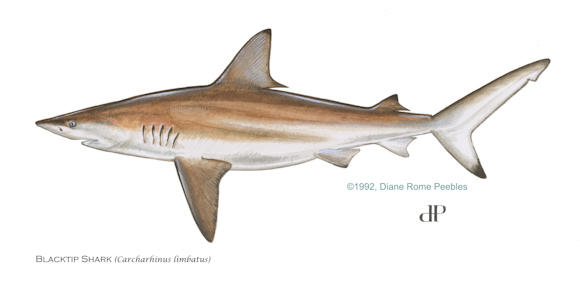
Blue Shark
Identification: Long slender body with narrow pectoral fins. Blue body color fading to white belly.
Behavior and Characteristics: Adults can mature up to 12.5 feet and usually feeds on fish, small sharks, and squid.
Habitat: Found mostly in off-shore oceanic waters. Can be found near large off-shore reef structures.
Handling: Use caution in handling all sharks. The Blue Shark has large fin shaped serrated teeth and a very large mouth.
Bag Limit Information: 54″ Minimum fork length. 1 per harvester or 2 per vessel.
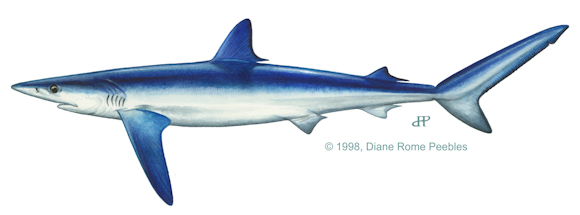
Bonnethead Shark
Identification: Head is shaped similar to a shovel. Often misidentified as a Hammerhead Shark. Gray color.
Behavior and Characteristics: Adults can mature to nearly 5 feet and usually eats crab and other crustaceans.
Habitat: Found mostly near shore lines and shallow coastal waters.
Handling: Use caution in handling all sharks. The Bonnethead Shark has short arrow shaped teeth.
Bag Limit Information: No minimum size restriction. 1 per harvester or 2 per vessel.

Bull Shark
Identification: Brown/Gray back fading to white belly. Blunt snout that is shorter than width of mouth.
Behavior and Characteristics: Adults can mature up to 10 feet and are known to travel into fresh waters. Aggressive and feared shark species.
Habitat: Freshwater, Coastal waters, near and off-shore.
Handling: Use caution in handling all sharks. The Bull Shark has large triangular shaped serrated teeth.
Bag Limit Information: 54″ Minimum fork length. 1 per harvester or 2 per vessel.
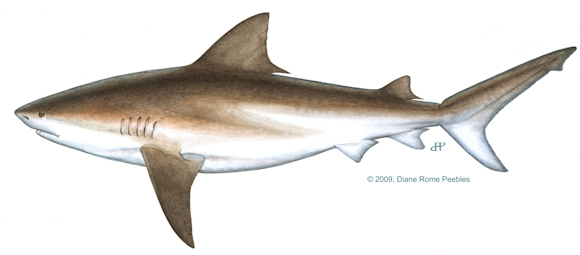
Reef Shark
Identification: Gray to Gray-Brown back fading to white belly. Interdorsal ridge present.
Behavior and Characteristics: Adults can mature up to 8 feet and usually eats a variety of fish.
Habitat: Found mostly near coral reefs and is rarely seen north of the Florida keys.
Handling: Use caution in handling all sharks. The Caribbean Reef Shark has large triangular shaped serrated teeth.
Bag Limit Information: It is illegal to harvest and possess Caribbean Reef Sharks. Release Immediately.
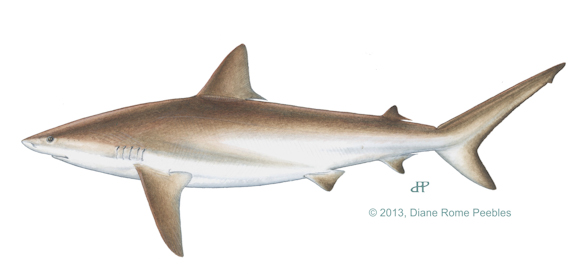
Dusky Shark
Identification: Bronze-gray to blue-gray fading to a white belly with a snout equal to mouth width.
Behavior and Characteristics: Adults can mature up to 12 feet and feeds on other sharks, fish, and squid.
Habitat: Near and off-shore waters and have been known to live 40 years.
Handling: Use caution in handling all sharks. The Dusky Shark has large triangular shaped serrated teeth.
Bag Limit Information: It is illegal to harvest and possess Dusky Sharks. Release Immediately.
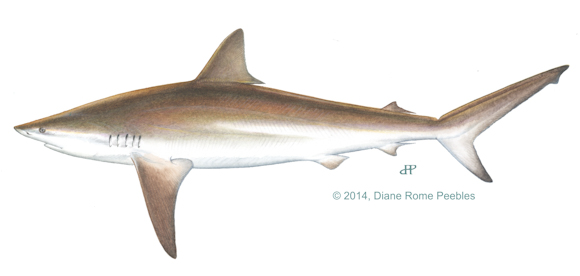
Finetooth Shark
Identification: Long slender body with long gill slits. Gray-blue back fading to white belly.
Behavior and Characteristics: Adults can mature up to 5 feet and usually feeds on small fish and squid.
Habitat: Found in most coastal near-shore waters on both Atlantic and Gulf coasts.
Handling: Use caution in handling all sharks. The Finetooth Shark has intermediate pike shaped serrated teeth.
Bag Limit Information: No minimum size restriction. 1 per harvester or 2 per vessel.

Lemon Shark
Identification: Blunt snout shorter than width of mouth. Yellow back fading to a white belly.
Behavior and Characteristics: Adults can mature up to 11 feet and is considered an incredibly aggressive shark. Feeds on anything with a pulse.
Habitat: All coastal waters including estuaries/fresh water.
Handling: Use caution in handling all sharks. The Lemon Shark has incredibly sharp triangular shaped teeth.
Bag Limit Information: It is illegal to harvest and possess Lemon Sharks. Release Immediately.

Nurse Shark
Identification: Blunt mouth with nasal barbels on each side. Brownish color with lighter color belly.
Behavior and Characteristics: Adults can mature up to 9 feet and is a bottom feeding shark.
Habitat: All coastal and near-shore waters. Often seen lying motionless on the bottom.
Handling: Use caution in handling all sharks. The Nurse Shark has wide, multi-ridged teeth.
Bag Limit Information: 54″ minimum fork length. 1 per harvester or 2 per vessel. Not commonly eaten.

Sand Tiger Shark
Identification: Sharply rounded and flattened snout. Light brown with irregular dark spots on body.
Behavior and Characteristics: Adults can mature up to 10 feet and are cannibalistic feeding on sharks and fish.
Habitat: Coastal waters near bays and deeper waters near reef systems.
Handling: Use caution in handling all sharks. The Sand Tiger Shark has razor sharp pike shaped teeth.
Bag Limit Information: It is illegal to harvest and possess Sand Tiger Sharks. Release Immediately.

Sandbar Shark
Identification: Broadly rounded and short snout. Brown/gray back fading to white belly.
Behavior and Characteristics: Adults can mature up to 8 feet and often a bottom feeding shark eating mostly shell fish.
Habitat: Coastal and off-shore waters typically at depths between 60 and 200 feet.
Handling: Use caution in handling all sharks. The Sandbar Shark has triangular shaped serrated teeth.
Bag Limit Information: It is illegal to harvest and possess Sandbar Sharks. Release Immediately.

Scalloped Hammerhead
Identification: Flattened head extends to hammer like lobes on each side with indentation at its midpoint.
Behavior and Characteristics: Adults can mature up to 12 feet and mainly eats fish, stingrays, and squid.
Habitat: Predatory fish that resides mostly in coastal to off-shore waters.
Handling: Use caution in handling all sharks. The Scalloped Hammerhead has arrow shaped serrated teeth.
Bag Limit Information: It is illegal to harvest and possess Scalloped Hammerhead Sharks. Release Immediately.

Shortfin Mako
Identification: Crescent moon shaped tail with deep blue back fading to white belly.
Behavior and Characteristics: Adults can mature up to 12 feet and is an incredibly strong swimmer that sometimes leaps out of water when hooked.
Habitat: Off-shore often seen at surface.
Handling: Use caution in handling all sharks. The Shortfin Mako Shark has large very sharp pike shaped teeth.
Bag Limit Information: 54″ minimum fork length. 1 per harvester or 2 per vessel.

Smooth Dogfish
Identification: Gray-brown back fading to lighter color belly. Small slender shark with spiracles present.
Behavior and Characteristics: Adults can mature up to 5 feet and commonly a bottom feeding shark that eats shell fish.
Habitat: Commonly found in bays and near-shore coastal waters including reefs and banks.
Handling: Use caution in handling all sharks. The Smooth Dogfish shark has oval shaped serrated teeth.
Bag Limit Information: No minimum size requirement. 1 per harvest or 2 per vessel.

Spinner Shark
Identification: Gray-bronze back fading to white belly. Has anal fin with black tip and often confused for Blacktip Shark.
Behavior and Characteristics: Adults can mature up to 9 feet and known for leaping out of water spinning when hooked.
Habitat: Coastal to off-shore waters and normally found following large bait pods.
Handling: Use caution in handling all sharks. Spinner sharks have long pike shaped serrated teeth.
Bag Limit Information: 54″ minimum fork length. 1 per harvester or 2 per vessel.

Spiny Dogfish
Identification: Blue-gray back with white spots and fading to a white belly. Slender with long narrow pointed snout.
Behavior and Characteristics: Adults can mature up to 5 feet and commonly forages in large schools for fish and squids.
Habitat: Coastal waters on the Atlantic coast found usually close to the bottom.
Handling: Use caution in handling all sharks. The Spiny Dogfish Shark has oblong ridged teeth.
Bag Limit Information: It is illegal to harvest and possess Spiny Dogfish Sharks. Release Immediately.
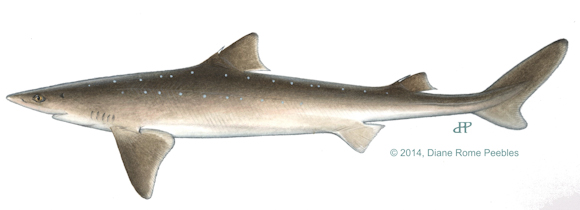
Thresher Shark
Identification: Caudal fin upper lobe nearly as long as the body with brown color and white belly.
Behavior and Characteristics: Adults can mature up to 20 feet and caudal fin is used as a whip to stun schools of fish.
Habitat: Coastal and off-shore waters found generally following large pods of bait fish.
Handling: Use caution in handling all sharks. The Thresher Shark has an incredibly powerful tail and pike shaped teeth.
Bag Limit Information: 54″ minimum fork length. 1 per harvester or 2 per vessel.

Tiger Shark
Identification: Tiger like vertical bars that fade with age. Spiracles present with light gray backs and dark blotches.
Behavior and Characteristics: Adults can mature up to 16 feet, second only to Great White Sharks in human attacks.
Habitat: All Coastal and off-shore waters primarily in deeper waters chasing large pods of bait fish.
Handling: Use caution in handling all sharks. The Tiger Shark is an extremely dangerous shark with large serrated teeth.
Bag Limit Information: It is illegal to harvest and possess Tiger Sharks. Release Immediately. Extreme Caution.

The best in the Business.
Vetting: Just because a Charter Fishing Captain has a license doesn’t mean he is a “people person” or has the appropriate tackle for the adventure that our guests want to experience. Our Captains are put through a comprehensive vetting process to ensure that our guests are happy and want to return.
Gear: A nice guy with all the right licenses and a boat is great…but that doesn’t mean he is qualified to take guests out to tackle big fighting fish. We inspect all of our Captains gear, tackle, and boat to qualify them for the kind of trophy fishing our guests want to do.
